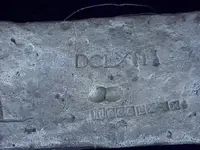HOLA amigos,
Lamar wrote
The Jesuits succeeded in their labors and this can evidenced in the survival of the native American peoples of today. Their cultures may have disappeared but their bloodlines have carried forward and it's my very humble opinion that we all owe the Jesuits a huge THANK YOU for their heroic efforts in this regard
Thank you? For what?



According to the Franciscan fathers who followed on the heels of the Jesuits, they found the Indios utterly un-instructed in much of anything, other than they expected that they would be forced to work for the padres. In fact if we examine the Amerindian areas most influenced by the Jesuits, do we see people living in prosperity, or people living in poverty? The Jesuits may have been successful in "
protecting" the Indios from the "evil" Spaniards who wanted them for slaves, but what does it say when these same Indios were running away from the missions, in order to go to work in the mines? Even in the case I mentioned earlier, the Indio testified, quote
So because of this and because the fires of rebellion were getting very hot, I decided to leave the village and went to live among the Spaniards. With this purpose I went to the ranch of Don Bernardo de Urrea to look for my horses, and then I returned to get my children with whom I went to Agua Caliente. Even then I was not safe from the persecution of the Fathers, because Lieutenant Don Cristóbal Yañez told me, "You must leave here because I have a letter from Father Jacobo Sedelmayr instructing me to give you fifty lashes and banish you from these parts."
<
Pedro de la Cruz Chihuahua, Santa María Suamca, November 29, 1751" (AGI, Guadalajara 419, Francisco Padilla Testimony, 3m-55, pages 28-35>


...our history revisionists and Jesuit apologists seem to wish to deny and gloss over the fact that the mission system was rather brutal, strict and virtual enslavement for the Amerindians who were baptized into it. I do not see any justification in granting a huge
THANK YOU to the Jesuits for their work, based on the results.
Lamar also wrote
Also, as a point of fact, Fr. DeSmet did not discover a gold mine, rather he discovered very rich gold deposits, the exact location of which he never devulged, and the reason he cited for refusing to divulge the location of the deposits was because he didn't wish for anyone *to disturb his children*, that being the Amerindians living in the Black Hills region of North Dakota. He spoke of the Black Hills deposits publicly only once in his lifetime, that being at a banquet which was given in his honor at St. Louis University, in St. Louis, Mo. (a Jesuit funded and run university, by the way) around 1866 AD. He took the secret with him to his grave. That was a very honorable man, in my very humble opinion.
In his own letter written to his brother, he refers to it as a "mine" and this is how it is commonly referred to among history books. The fact that he made the existence public knowledge in 1866 certainly did nothing to help hold back the "evil white men" from entering the Black Hills, in fact it encouraged them to do so. Several expeditions were organized in that period, of which none were successful. The first "proof" of gold in the hills came not from father DeSmet nor the Custer expedition but from the Dakota Indians, who brought nuggets in to trade at a fort. Funny how our good Jesuit fathers, with rules against having any kind of mines or knowledge of them, frequently seem to find those very minerals sought by the "evil" European colonists.
I would also point out that the gold regions of the Black Hills lie mostly in
South Dakota, with a small adjacent region in adjoining Wyoming, but none in
NORTH Dakota. (Still don't know why they divided these two states
north-south, when
east-west would have made perfect sense and was what the Black Hillers even asked for.

Politicks......

)
Now Lamar has denied that the Jesuits were involved in gold and/or silver mining. Here is what the info page for the city of Cananea Sonora has to say, quote
The mining activity within Cananea has a lengthy history. The registry dates from 1760, when Jesuit missionaries discovered abundant deposits of gold and silver, resulting in the beginning of mining operations in Cobre Grande (The Great Copper mine). Mr. William Cornell Green was the founder and creative mind behind The Cananea Consolidated Copper Company.
http://www.gotosonora.com/cananea-son-mx.htm
Or how about this, quote
"In at least one documented case, the relationship between missionaries and miners in connection with food supply resulted in a singular activity on the part of the priests. Mining in Sonora was not limited entirely to lay Spaniards. The Jesuits of Matape mission also engaged in the extraction and refining of silver ores from deposits near Tecoripa, not far from San Miguel Arcangel. According to the rules of the Jesuit order, priests were forbidden to own, operate, or even acquire knowledge of mining. But apparently, ownership of the mines in question had been signed over to the mission by a Spanish miner in payment for debts he incurred for supplies obtained from the padres. Moreover, the priests claimed that the mines belonged to the College of San Jose' at Matape, not to the mission itself, and thus the superiors permitted continuation of the "forbidden" activity. During the late seventeenth century annual proceeds from the Tecoripa mines under church management ranged from three thousand to twelve thousand pesos, a substantial windfall for the college and the missionaries.
<pp 62, Sonora: its geographical personality
By Robert Cooper West, 1993>
We could debate whether the Jesuits were a positive or negative influence on southwestern history probably
ad nauseum. I think we can lay the wholesale denials of Jesuit mining to rest once and for all however, and we ought to also lay to rest the idea that there were many thousands of Jesuit mines and/or treasures scattered literally all over the American (and Mexican) west - there was never
that much activity. It has become common practice to refer to ancient mines as "Jesuit" when most were actually just Spanish, and some were even owned and operated by the Indios themselves (the southern Pimas and Opatas especially were active and successful miners). The Jesuits were the religious leaders and have thus become "tied" to many more mines than they truly had any kind of ownership or management of, because they were perceived as the masters by the Indios from whom most of our treasure legends originate. As with many parts of history, the truth lay between the extremes we are offered.

Oroblanco


Ok in reply sort of to post 521 above,Gollum , here is a section from a map showing the Martydom of Father Saeta, dated 1695, made by Father Kino. Useing a magniying glass I can determine that the lettering is quite different and distinct from what I believe are modern letters showing on your gold or silver ingot. True the ingot and map were not made by and inscribed by the same persons, but the lettering should be in the same time peroid, and very similar.





 According to the Franciscan fathers who followed on the heels of the Jesuits, they found the Indios utterly un-instructed in much of anything, other than they expected that they would be forced to work for the padres. In fact if we examine the Amerindian areas most influenced by the Jesuits, do we see people living in prosperity, or people living in poverty? The Jesuits may have been successful in "protecting" the Indios from the "evil" Spaniards who wanted them for slaves, but what does it say when these same Indios were running away from the missions, in order to go to work in the mines? Even in the case I mentioned earlier, the Indio testified, quote
According to the Franciscan fathers who followed on the heels of the Jesuits, they found the Indios utterly un-instructed in much of anything, other than they expected that they would be forced to work for the padres. In fact if we examine the Amerindian areas most influenced by the Jesuits, do we see people living in prosperity, or people living in poverty? The Jesuits may have been successful in "protecting" the Indios from the "evil" Spaniards who wanted them for slaves, but what does it say when these same Indios were running away from the missions, in order to go to work in the mines? Even in the case I mentioned earlier, the Indio testified, quote

 )
)
